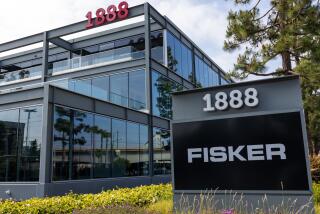On a Roll, Chrysler Now Has to Fight for the Wheel
- Share via
One of the weirder aspects of the Chrysler takeover bid launched last week by investor Kirk Kerkorian and Lee Iacocca, the company’s former chairman, is that it seems to ignore the company itself--its needs and ambitious investment plans.
And so, pushed by large egos and a destructive flaw in the U.S. financial system, the bid threatens Chrysler’s future.
The offer itself would loot the company treasury. Instead of focusing on ways to help Chrysler, Kerkorian proposes to finance part of his $20.8 billion offer for 90% of the company by using $5.5 billion of Chrysler’s cash reserves.
For most of his purchase Kerkorian would burden the company with $12 billion of additional debt.
The financier put forward no other details of his bid last week. But institutional shareholders were quick to demand that Chrysler use its cash to increase a $1 billion stock repurchase program that was initiated in January in response to earlier pressure from Kerkorian.
The suggestion that Chrysler use its cash only as a honey pot for stockholders assumes that the company has no necessary use for the money. But it has very good uses: Current management led by Chairman Robert Eaton built up a $7.5-billion cash reserve as a defense against the auto business downturn that is now beginning. Having narrowly escaped bankruptcy twice in the last 15 years, Chrysler understands the value of prudence.
Also the company needs the money for investment. Chrysler has come back from near death in the last four years on the strength of efficient production, stylish models and a very strong U.S. car market.
But it must invest more today if it wants to remain strong tomorrow. “Chrysler must renew its plants if it wants to be successful over the long term,” says David Cole, head of the University of Michigan’s Office for the Study of Automotive Transportation.
Chrysler is aware of that and plans to invest $23 billion over the next four years, to install new manufacturing systems and develop new designs and products. That’s double the company’s capital investments over the last four years, when it had other demands to pay down debt and replenish its pension plan.
It also is adding Thailand and Indonesia to a network of overseas ventures in Austria, Venezuela and Malaysia, where it assembles minivans and Jeeps exported from the United States. It plans to invest $200 million in Vietnam and is involved in negotiations to build minivans in China.
Those are the markets of the future at a time when car sales are growing 1% a year, if at all, in the United States, Europe and Japan.
*
Chrysler is not perfect. The quality of its products still needs work, according to consumer surveys. And the company needs to do more overseas.
But on their record of recovery, the management team of Eaton and President Robert Lutz have earned the right to go forward. Chrysler earned $3.7 billion last year on $50 billion in sales; earned almost $600 million in the first quarter’s business slowdown. Its stock, even at $39 a share before the takeover bid, is four times its price in 1989 when Kerkorian stepped in with a timely investment.
But now Kerkorian and Iacocca threaten to mortally wound the company, possibly by scattering the management that brought Chrysler back, made it the world’s low-cost producer and gave it stylish cars.
“Four years ago if you saw a Chrysler car on a California freeway, it was a rented car or it had dealer plates,” says Christopher Cedergren, of Auto Pacific Group, a Thousand Oaks, Calif., consulting firm. “Today, actual customers are buying Chrysler.”
Another possibility is that the bid will leave Chrysler vulnerable to the shakeout in the world car industry that experts say is ready to begin.
Most foreign car companies denied for the record last week that they were contemplating bids for Chrysler. But the pressures are immense for many to make themselves larger or increase their product lines with Chrysler’s attractive Jeeps and minivans.
In a few years, European markets will be fully opened by law to competition from stronger Japanese car makers. Fiat of Italy, Peugeot and Renault of France and perhaps Volkswagen of Germany will be directly threatened.
At the same time Japanese companies have become the highest-cost producers in the world, partly because of car-making practices more suitable to boom times and partly due to the strong yen.
“One merger bid in this industry could set off a free-for-all,” suggests the University of Michigan’s Cole, who says that Samsung, the large South Korean trading company wants to get into car production, too.
In any takeover scramble, Chrysler would be vulnerable--especially for buyers using strong German marks or yen to buy “cheap” dollar assets. But a bid from a foreign company is just what trader Kerkorian appears to be looking for.
And what is Iacocca looking for? Another trip for his ego. Iacocca is 70 years old and unhappy in retirement, say car people who know him. He didn’t want to retire in 1992 and wants to get his hand back into the business one more time.
It’s kind of sad for a man of such accomplishments not to rest easily. It should not be forgotten that Iacocca’s energy and verve, as much as the government’s loan guarantee, rescued Chrysler in 1981 and that he led development both of the minivan in the 1980s and the Ford Mustang in the 1960s.
What could happen? A real takeover fight would be bloody, with management and unions seeking defenders, and the U.S. government scrutinizing any foreign bid. The outcome would leave even a victorious Chrysler with its momentum broken.
*
If they really want to do a good company a favor, Kerkorian should cash in his 10% block of stock, which is worth two and a half times what he paid for it. And Iacocca should rest on his laurels.
That way Chrysler would remain an outstanding example of the glory of the U.S. financial system, which is that it allows companies to remake themselves, and not an example of the hidden flaw of the U.S. system--which is that it does not encourage patient capital.






